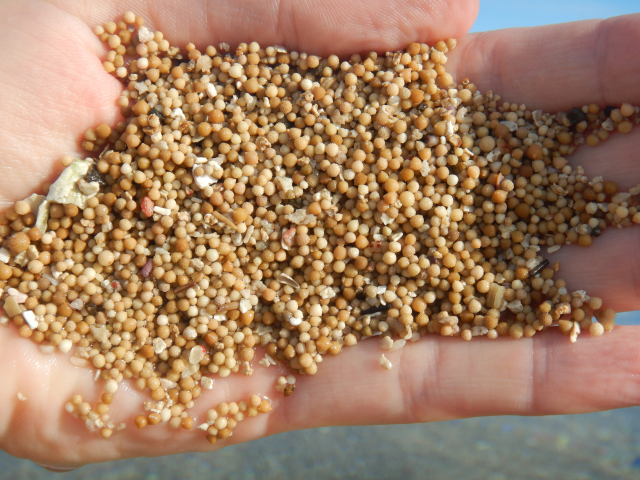25/05/2021 | A new study of tropical foraminifera shows how these calcifying single-celled organisms react to acidification and warming of the oceans. Marine geoecologist Dr Marleen Stuhr from the Leibniz Centre for Tropical Marine Research (ZMT) in Bremen (Germany) led the study and concludes that foraminifera might be able to withstand conditions predicted for the marine waters in the future. Aside from ZMT, researchers from the Leibniz Institute for Analytical Sciences (ISAS) in Dortmund (Germany) and Northeastern University in Boston (USA) were involved in the study which was recently published in the science journal Oceans.
Foraminifera are found almost everywhere in the marine realm – from the intertidal zone to the deep-sea trenches, from the tropics to the poles. Some species float as plankton in the water, others live on the sea floor. These tiny marine organisms produce calcareous shells and contribute to the formation of tropical sandy beaches which are largely made up of calcium carbonate from corals, calcareous algae, and foraminifera.
Dr Marleen Stuhr's team studied a special group of foraminifera called large benthic foraminifera (LBF) that live in tropical coral reefs. The researchers looked at the species Amphistegina lobifera from the northern Red Sea to find out how these reef organisms react to different climate change scenarios.
New insights into the symbiosis between foraminifera and algae
Like tropical corals, foraminifera live in symbiosis with algae. The algal symbionts supply their host organisms with energy from photosynthesis. With changing environmental conditions such as rising water temperature or increasing CO2 concentrations the interplay between the organisms changes.
In the ocean, carbon dioxide from the atmosphere reacts with water to carbonic acid, and the pH of the water decreases – a process known as ocean acidification. While the algae are fertilised by higher CO2 levels, the calcification process within the foraminifera can be disturbed by ocean acidification. This can also be seen in a changed protein composition of both symbiosis partners.
“In the lab we exposed the foraminifera to elevated temperatures for two months. We also cultivated them simultaneously in seawater with different pH values in order to simulate of different scenarios of ocean acidification,” Stuhr says about the experiments. “Then we determined the growth and colour of the foraminifera and the pore sizes in their calcareous shells,” she adds.
The scientists also took a close look at the algal symbionts. By measuring the chlorophyll content of the algae, Stuhr was able to draw conclusions about their fitness.
“Using these parameters, we were able to see how the fitness of the organisms was affected by different scenarios and whether the interaction between foraminifera and algae changed,” Stuhr explains. ”A protein analysis of host and symbionts showed how they could adapt to and resist new environmental conditions,” she says.
Resilient to increased water temperature and ocean acidification
Marleen Stuhr's team found that the foraminifera Amphistegina lobifera from the northern Red Sea were relatively unaffected by water temperatures of up to 31°C. For several weeks the species could also withstand high ocean acidification with CO2 levels of more than 3,000 ppm, which is almost eight times as high as today and might be reached in the year 2500.
“The resilience of the foraminifera in the northern Red Sea is most likely due to the fact that their symbiotic algae benefit from the increased CO2 concentrations and can supply their hosts with more energy. The foraminifera literally become little powerhouses,” says Stuhr.
“The combination of temperature increase and rising ocean acidification does seem to reduce the stability of the calcareous shells of the foraminifera, as some protein groups in the foraminifera showed strong changes. This shows us that calcium production was potentially affected and some cell processes were switched in the course of the stress response. But the holobionts as a whole – host organism and symbiont together – were not much affected. Stressors should therefore not be considered individually,” she adds.
The scientist concludes that although the combination of ocean acidification and warming produced very different and complex responses in photosymbiotic calcium producers such as foraminifera, the effects on growth and vitality were small.
Publication:
Stuhr, M., Cameron, L.P., Blank-Landeshammer, B., Reymond, C.E., Doo, S.S., Westphal, H., Sickmann, A., Ries, J.B. Divergent Proteomic Responses Offer Insights into Resistant Physiological Responses of a Reef-Foraminifera to Climate Change Scenarios. Oceans 2021, 2, 281-314. https://doi.org/10.3390/oceans2020017





